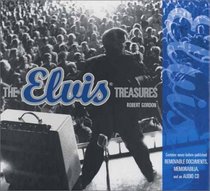Search -
The Elvis Treasures
The Elvis Treasures
Author:
On October 3, 1945, ten-year-old Elvis Presley climbed atop a chair to reach the microphone and performed the song "Old Shep" for a crowd of several hundred at the Tupelo fair, coming in fifth place in the talent contest. Ten years later, the King created his first full-scale riot after an appearance in Jacksonville at a baseball park. Girls pou... more »
Author:
On October 3, 1945, ten-year-old Elvis Presley climbed atop a chair to reach the microphone and performed the song "Old Shep" for a crowd of several hundred at the Tupelo fair, coming in fifth place in the talent contest. Ten years later, the King created his first full-scale riot after an appearance in Jacksonville at a baseball park. Girls pou... more »
ISBN-13: 9780375506260
ISBN-10: 0375506268
Publication Date: 7/2002
Pages: 64
Rating: ?
ISBN-10: 0375506268
Publication Date: 7/2002
Pages: 64
Rating: ?
0 stars, based on 0 rating
Genres:
- Biographies & Memoirs >> Arts & Literature >> Composers & Musicians >> Rock
- Biographies & Memoirs >> Arts & Literature >> Entertainers
- Biographies & Memoirs >> General
- Biographies & Memoirs >> People, A-Z >> ( P ) >> Presley, Elvis
- Humor & Entertainment >> Music >> Musical Genres >> Rhythm & Blues




